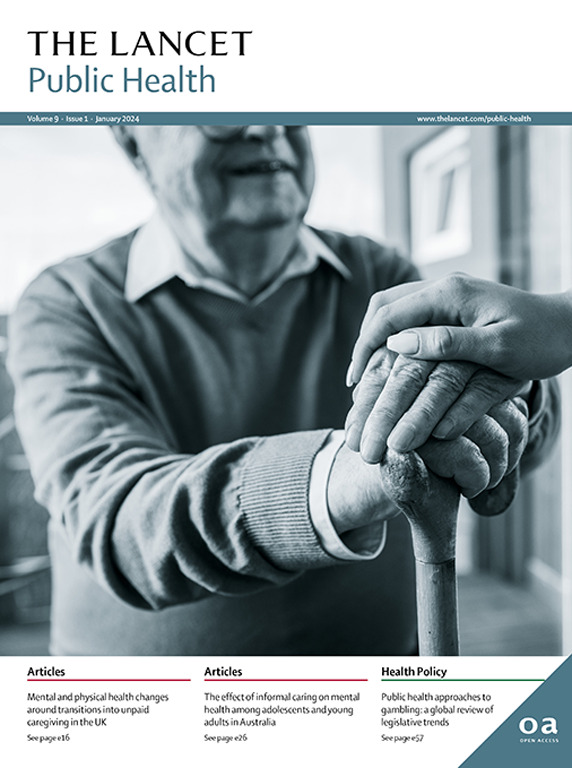Hepatitis A vaccination coverage in adults with chronic liver disease in primary care in England: a retrospective cohort study
IF 25.2
1区 医学
Q1 PUBLIC, ENVIRONMENTAL & OCCUPATIONAL HEALTH
引用次数: 0
Abstract
Background
International guidelines recommend the administration of two doses of pre-exposure hepatitis A vaccination for people with chronic liver disease to prevent severe complications. We aimed to describe hepatitis A vaccination coverage and mortality in adults with chronic liver disease in England.Methods
We did a retrospective cohort study using routinely collected medical record data from the Oxford-Royal College of General Practitioners Research and Surveillance Centre (RSC) primary care sentinel network. We included people aged 18 years or older who were diagnosed with chronic liver disease between Jan 1, 2012, and Dec 31, 2022. The primary outcome of interest was hepatitis A vaccination. Hepatitis A vaccination coverage was calculated using the number of vaccinated people with chronic liver disease as the numerator and the chronic liver disease population in the RSC dataset as the denominator. We compared individual characteristics by vaccination status using descriptive statistics. We used a multistate survival model to estimate the transition probabilities between four states: (1) diagnosis of chronic liver disease; (2) first hepatitis A vaccination; (3) second hepatitis A vaccination; and (4) death.Findings
664 571 individuals aged 18 years or older with chronic liver disease were identified from the RSC sentinel network population, of whom 625 079 individuals were included in our analysis. Of 625 079 individuals with chronic liver disease, 13 875 (2·2%) had received a first hepatitis A vaccination, 3007 (0·4%) had received a second dose, 732 (5·3%) of 13 875 vaccinated individuals died, and 101 065 (16·5%) of 611 204 individuals without vaccination died during the study period. Adjusting for death as a competing risk, vaccination was more likely among younger age quintiles (hazard ratio 5·46 [95% CI 5·13–5·81]), non-smokers (1·59 [1·54–1·65]), residents of urban areas (1·28 [1·21–1·35]), individuals with higher socioeconomic status (1·06 [1·03–1·10]), and individuals with a diagnosis of metabolic dysfunction-associated steatotic liver disease (MASLD; 1·71 [1·64–1·78]). Individuals with a history of harmful alcohol use (0·36 [0·32–0·39]), type 1 diabetes (0·46 [0·36–0·57]), chronic kidney disease (0·63 [0·57–0·70]), or mental disorders (0·66 [0·64–0·69]) were less likely to be vaccinated. The lowest risk of mortality was in people with chronic liver disease of infectious or autoimmune aetiology and in people with MASLD.Interpretation
Hepatitis A vaccine uptake among people with chronic liver disease in England is low, with disparities by age, location (urban vs rural), and socioeconomic status. Steps should be taken to reduce the inequalities in vaccine administration.Funding
GlaxoSmithKline's Investigator Sponsored Studies Program.在英格兰初级保健成人慢性肝病的甲型肝炎疫苗接种覆盖率:一项回顾性队列研究
国际指南建议对慢性肝病患者进行两剂暴露前甲型肝炎疫苗接种,以预防严重并发症。我们的目的是描述甲型肝炎疫苗接种覆盖率和死亡率成人慢性肝病在英格兰。方法采用常规收集的牛津-皇家全科医师学院研究与监测中心(RSC)初级保健哨点网络的病历数据进行回顾性队列研究。我们纳入了2012年1月1日至2022年12月31日期间被诊断患有慢性肝病的18岁或以上的患者。主要研究终点为甲型肝炎疫苗接种。甲型肝炎疫苗接种覆盖率以慢性肝病患者接种疫苗的人数为分子,以RSC数据集中的慢性肝病人群为分母计算。我们用描述性统计比较了接种状态的个体特征。我们使用一个多状态生存模型来估计四种状态之间的转移概率:(1)慢性肝病的诊断;(2)首次接种甲型肝炎疫苗;(3)第二次甲型肝炎疫苗接种;(4)死亡。研究结果:从RSC哨点网络人群中确定了664 571名18岁或以上的慢性肝病患者,其中625 079人纳入了我们的分析。在625079例慢性肝病患者中,13875例(2.2%)接受了第一次甲型肝炎疫苗接种,3007例(0.4%)接受了第二次甲型肝炎疫苗接种,13875例接种者中有732例(5.3%)死亡,611204例未接种者中有101065例(16.5%)死亡。将死亡作为竞争风险调整后,接种疫苗的可能性更大的人群是年龄较小的五分位数(风险比为5.46 [95% CI为5.13 - 5.81])、非吸烟者(风险比为1.59[1.54 - 1.65])、城市居民(风险比为1.28[1.21 - 1.35])、社会经济地位较高的个体(风险比为1.06[1.03 - 1·10])和诊断为代谢功能障碍相关脂肪变性肝病(MASLD;1·71(1·64 - 1·78])。有有害酒精使用史(0.36[0.32 - 0.39])、1型糖尿病(0.46[0.36 - 0.57])、慢性肾病(0.63[0.57 - 0.70])或精神障碍(0.66[0.64 - 0.69])的个体接种疫苗的可能性较低。死亡风险最低的是感染性或自身免疫性慢性肝病患者和MASLD患者。在英格兰,慢性肝病患者的甲型肝炎疫苗接种率较低,存在年龄、地点(城市与农村)和社会经济地位的差异。应采取步骤减少疫苗接种方面的不平等现象。资助葛兰素史克的研究者赞助研究项目。
本文章由计算机程序翻译,如有差异,请以英文原文为准。
求助全文
约1分钟内获得全文
求助全文
来源期刊

Lancet Public Health
Medicine-Public Health, Environmental and Occupational Health
CiteScore
55.60
自引率
0.80%
发文量
305
审稿时长
8 weeks
期刊介绍:
The Lancet Public Health is committed to tackling the most pressing issues across all aspects of public health. We have a strong commitment to using science to improve health equity and social justice. In line with the values and vision of The Lancet, we take a broad and inclusive approach to public health and are interested in interdisciplinary research.
We publish a range of content types that can advance public health policies and outcomes. These include Articles, Review, Comment, and Correspondence. Learn more about the types of papers we publish.
 求助内容:
求助内容: 应助结果提醒方式:
应助结果提醒方式:


